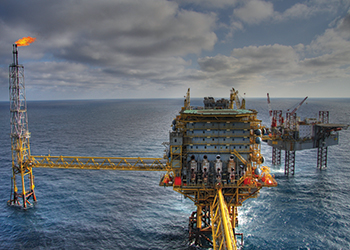
 Advanced inspection tech prepares for future challenges
Advanced inspection tech prepares for future challenges
Technology is playing an increasing role in helping operators use data to not only help better manage their offshore assets but also maximise the lives of these assets, Matthew Tremblay, ABS Senior Vice President, Global Offshore, tells OGN
Whilst offshore exploration continues to uncover new reserves to be developed, oil recovery techniques have extended the lifespan of existing fields, in turn maximising the lives of the assets related to them. But this creates a new challenge, namely understanding an asset’s remaining service life in the field.
Operators must evaluate the challenges associated with maintaining existing facilities in service. These challenges are more severe on deepwater fields and include:
• Structural and mechanical integrity of assets.
• Impact caused by refurbishment upgrades and repairs.
• Efficiency of existing machinery and systems.
• Obsolescence of equipment and required replacement costs.
The structural integrity of the floating assets used in deepwater fields, as well as their mooring system integrity are critical to a successful life extension. The original design of these assets considers a set of assumed conditions that include design fatigue life and strength parameters, as well as corrosion characteristics.
The evaluation of these assets for life extension must consider the environmental events that the asset has been exposed to, the loading and operational conditions, the actual condition of the structural elements and the modifications and upgrades made throughout the operational life of the unit that may impact the strength and fatigue characteristics. It also needs to take into account corrosion and other degradation identified during lifecycle inspections.
Critical to this is the evolution of technology and its potential to increase performance and productivity through its ability to analyse an asset’s condition and operational performance.
USING YOUR DATA ECOSYSTEM
Many of the critical answers to asset management already lie within an asset’s data. What emerging technology is allowing us to do is trap, harvest and analyse this data in one place to provide greater clarity and understanding.
Key questions when looking at asset longevity and performance will include:
• Where are emergent reliability risks?
• What are my corrosion degradation patterns?
• Which assets have abnormal operations and why?
• What is the condition of my critical structural connections?
• What is the impact of operational variation on my asset’s health?
• Are there patterns in my spare parts consumption?
• Which of my processes have reliability issues?
• And ultimately, is my asset performing at optimal level?
So where do we start? It all starts with collecting the data that will often already have been processed and analysed either electronically or on paper from the original design information, the engineering assessments and analysis, the inspection records and survey results.
 |
Tremblay ... emphasis on data |
Environmental data may be acquired from industry sources or measured onboard. Operational data such as loading patterns, production profiles, failure modes, maintenance data, are also available either measured manually or through monitoring systems.
Data is also generated from repairs, maintenance, warranty claims, case finding, CMMS data as well as generally available sources such as ocean condition information.
The key is to maximise the use of this data, processing it, analysing it and offering the conclusions that will greatly benefit the operator.
Traditionally, all of this data has been kept in different silos. Only by combining these data sets from multiple sources with modern data management technologies, can you make better decisions exercising big data analytics, which is the concept of using different data sources to lead you to insights.
What this also enables is a shift from a calendar-based maintenance approach, to a condition-based approach. The goal in moving to a condition based system is that you are letting the condition of the asset, be it a pump, or an FPSO hull structure, tell you how often you need to inspect and maintain.
As part of the condition-based class approach, ABS has defined a digital asset framework that lays out the capabilities that support the end-to-end process – from data collection and pre-processing, to a digital twin that maintains and analydes the data, to visualisations and analysis outputs that support risk- based decision making.
Recognising the value of incorporating digital technology, data analytics, and advanced inspection technologies helps us to prepare for current and future challenges through a streamlined class experience and a closer alignment with ongoing operation and maintenance activities.
It leverages data and digital technologies to provide greater insights into the condition of the asset to optimise inspection activities, support classification decision-making and provide greater flexibility than the traditional prescriptive inspection requirements.
This approach builds from the same concepts as the Risk-Based Inspection (RBI) regime that has already been developed and implemented by the industry.
RBI determines the inspection intervals and scope based on the calculated risk profile of the individual elements in addition to other historical data. The condition-based class approach incorporates digital technologies to improve RBI processes and promotes a more holistic inspection and maintenance system.
The digital tools available today enable us to ingest, store, track, and analyse condition data in a way that was never possible before.
Effective application of these digital tools are focused on three primary goals:
• Improving asset reliability
• Minimising the intrusiveness or impact of the Class process on offshore operations
• Supporting the improved profitability of the industry
Tools such as Digital Twin, or a "digital asset framework" can be used to support improved, condition based, asset management.
DATA SCIENCE FOR INFORMED DECISION-MAKING
The first stages of the digital asset framework is data collection and pre-processing. A digital twin utilises various data received from the offshore asset as well as data from the environment in which it is operating to build a virtual representation of the physical object. This data is collected over the life of the unit, from the early days of basic design through the operational phase.
Example of data to be collected includes:
• Original design documentation.
• Modification records.
• Inspection records.
• Environmental data.
• Operational data.
• Sensor data.
DIGITAL TWIN ALLOWS DEEPER INSIGHT THROUGHOUT ASSET LIFECYCLE
At the centre of the digital asset framework is the digital twin, which is the virtual representation of the physical asset, as well as its associated processes, systems and information. The digital twin is continuously updated throughout the asset lifecycle through a combination of the collected data, engineering models, and data analytics.
The digital twin provides a platform for information management and collaboration, where subject matter experts, managers, and all other decision makers share a common understanding of the asset’s current condition to support the decision-making process.
By enhancing information management and collaboration, a digital twin can enable:
• A single source of truth for all relevant data, analyses and models available at any time and kept current throughout the lifecycle of the asset.
• Controlled sharing of data, models, and updated asset information between stakeholders.
• Support decision makers with operational decisions by providing near real-time conditions of the assets and the capability to simulate possible future states based on planned operations.
• Inform maintenance and inspection planning based on actual asset state and risk profile.
Together these processes allow for the continuous degradation of the asset to be clearly understood, forming a solid base for a life extension evaluation.
USING PREDICTIVE ANALYTICS TO ENABLE CONDITION-BASED INSPECTIONS
Once a single source of truth has been established for the asset, it can be used to better forecast the evolution of future risks.
Data science enables the development of a predictive analytics process that supports the ultimate goal of shifting from the calendar-based, prescriptive inspection regime to a data-informed, condition-based inspection model.
Some of the characteristics of this predictive model include:
• Degradation forecasting: using acquired data to predict the degradation levels.
• Forward-looking decision-making: using analytics models to predict degradation levels.
A decision to extend the service life of an asset is now supported by the unit’s own data. A decision can be made using the forecasting tools, which will enable a clear vision of the remaining life and the suitability for additional service beyond original design life.
DATA ANALYSIS GUIDES A TARGETED INSPECTION REGIME
To address any critical elements identified during the service life of the unit that require attention based on the predctive analysis, the final stage of the framework is to use the analysis of the data to develop an inspection regime targeted to those elements.
The degradation forecast and associated determined risk provides guidance on the scope and frequency of the inspections as well as inspection sequencing.
The benefits of this approach include:
• Increased availability and flexibility: increasing operational availability of the asset by better aligning inspection activities with the asset operations
• Improving efficiency and productivity by using digital capabilities to automate portions of the workflow.
• Focused inspections: By focusing on the critical elements determined by the data analysis and risk assessment, operators may be able to reduce the impact of inspections on production.
• Management of persons on board: Using the results of data analysis, maintenance activities requiring technicians on board, will benefit from a streamlined and focused inspection regime.
• Materials and Logistics Management system: additional efforts can be devoted to the development of a targeted system to organise and properly manage the need of spare parts, manufacturer’s representatives, supply boat schedule, helicopter traffic, and other logistic activities.
CONCLUSION
The higher the visibility of an asset’s health to an operator, both on board and onshore, the greater the opportunity to improve performance and safety and maximise the service life of the asset.
Tools such as the ABS condition manager software can help visualise the condition of structural and machinery aspects of an FPSO. The digital solutions applied to the FPSO can impact the entire chain, from equipment and inventory to operational efficiency, including optimisation of inspections and onboard activities.
Using the results of data analysis and applying these results to the unit allows the operator to assess the conditions and availability of machinery and systems, better managing the asset and in turn maintaining the asset in operation beyond its original service life.
* ABS is one of the world’s leading providers of classification and technical advisory services to the marine and offshore industries.











































































